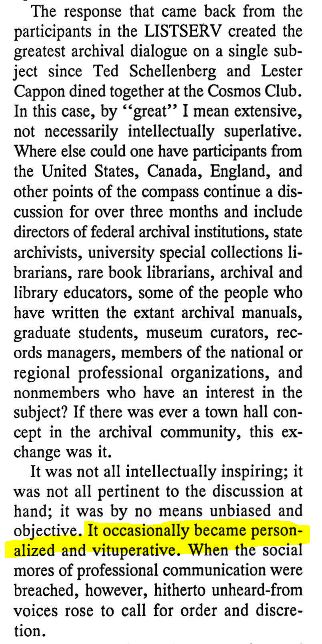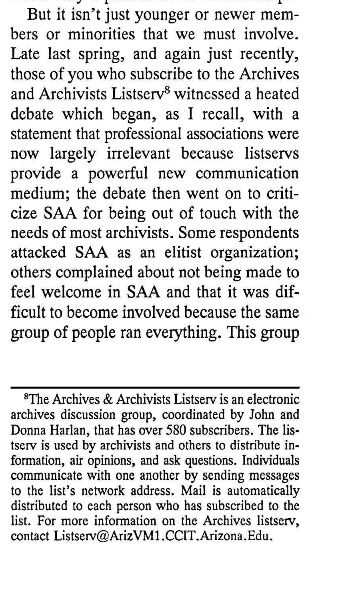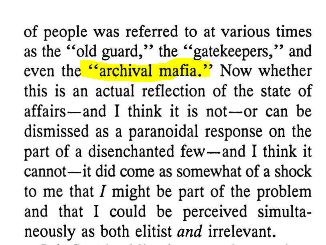Professionals Without Professionalism, Part 1
The big talk of the town right now within the American archivist profession is that a major listserv, known as Archives and Archivists, or A&A, is being shut down at the end of 2017. A&A is administered by the Society of American Archivists (SAA), and has been in existence for well over two decades. SAA is a membership-supported (i.e. dues-paying) organization, though non-members have long been able to subscribe to A&A. A&A has such a longstanding notorious reputation within the profession that it has its own derogatory nickname that’s been in use for years – #ThatDarnList (almost always hashtagged because it’s most frequently deployed on Twitter, where’s it’s been in use since at least 2009).
Why is A&A so notorious? Simply put, because A&A has a long track record of being a hostile environment for many archivists – especially women, people of color, and young/early-career archivists. Many archivists have written about this, these links from the last few years give a good overview:
https://storify.com/Zanish/thatdarnlist
https://archivasaurus.wordpress.com/2014/01/27/are-we-a-profession-or-arent-we/
http://annajcook.blogspot.com/2014/05/once-upon-listserv-thoughts-on.html
https://offtherecord.archivists.org/2014/06/27/the-de-evolution-of-the-archives-and-archivists-list/
https://thefeministlibrarian.com/2014/09/10/in-which-i-write-letters-open-letter-to-saa-re-thatdarnlist/
https://concernedarchivists.wordpress.com/2017/08/15/thatdarnlist-the-saga-continues/
It is also a problem that SAA has increasingly acknowledged since 2014. Read these two reports from the organization:
2014: https://www2.archivists.org/sites/all/files/0814-1-IV-D-A&AList.pdf
2017: https://www2.archivists.org/sites/all/files/1117-V-A-A&AList.pdf
Lest you think this problem has been brought on by “snowflake leftist social justice warrior” millenials who eat too much avocado toast and complain about unpaid internships, A&A has had a bad reputation way before anyone coined the term millenial. Things apparently got pretty wild in 1992-1993. Don’t believe me? Well go back and read these two pieces from American Archivist.
Frank Burke (1992) Letting Sleeping Dogmas Lie:
Anne Kenney (1993) SAA Is Us: Promoting Participation in the Work of the Society:
Like many other archivists, I’ve cheered the recent decision by SAA Council to end the listserv. I left active subscription to A&A a few years ago and have not returned. I have personally encountered the hostile atmosphere of A&A, and it’s become increasingly embarrassing to see how bullshit on the listserv comes off to new archivists and information professionals who are adjacent to archives. Archivists claim to be professionals, but judging from the listserv, it’s hard to see where some of our fellow archivists could actually claim any sense of professionalism. A&A has not been a good resource for years – many of the most knowledgeable people in our field left it long ago. In fact, the toxicity is now so notorious that it’s getting written about outside of our field. Somehow I don’t think this is the kind of public awareness that the Committee on Public Awareness had in mind.
SAA has said that it will be exploring other avenues for communication platforms in the coming months. SAA already hosts a number of other listservs – each of SAA’s sections have listservs, and non-members are allowed to subscribe to up to three of them.
One of the larger conversations provoked by the shutting down of A&A is the question of staying professionally involved. According to the #thatdarnlist hashtag, many of the subscribers to A&A are now concerned about losing access to this source of information about the profession. I’ve encountered a similar sentiment on a regional archivists listserv, and I find it strange. More on that in a forthcoming post.
Categorised as: professionalism, SAA



I’ve said it on Twitter and I repeat it here, what information professional cannot find information about their profession? We have publications being released on a regular basis from SAA, OCLC, and other groups about archives. We have blogs, twitter, and personal websites that provide pertinent, valid information about contemporary issues facing archives and archivists It’s embarrassing to watch.
On another note, this last gasp from the Listserv has shown me who I do not want to interact with on a professional level and who is worth my time.
By posting the commentary regarding the 1993 kerfuffle, you demonstrate that what the list is experiencing today is nothing “new.” What’s new (2011-2017) might be the snark and violent* denunciation of the current generation.
It’s important to recall that in 1993-94, the listserv existed separately from the SAA national organization. The quotes you selected reference a “heated debate” with stated positions about relevancy and perceived elitism that could be argued as true even today.
I would disagree with your comment that the list had a “bad reputation” back in the 1990s. When I was a “SNAP/newbie” in 1993-94, the list was a very important resource to me. Arguments and heated discussions were nothing new, but we also had questions, answers, lovely regional virtual picnics, humor, parody, and friendships. Ah, the parodies….I still have some of those printed out too.
The biting snarky tone of the present didn’t really emerge until the mid-2000s. I remember asking professional colleagues (IRL) when did it become acceptable to be “snarky” with one another and we traced it back to social media, predominantly Twitter and the idea that you could say anything online vs. how you might say it to someone face to face.
Keep in mind that many of us mid-career archivists didn’t grow up sharing every little thing about ourselves on social media either. When I started following the list, email was relatively new means of communicating to a larger audience. Our email was via Juno accounts and Higher Education Network accounts. I logged into AOL for the first time in 1995.
From 1995- around 2008, I maintained my professional persona and personal professional friendships separate from my closer/family personal preferences until social media emerged and blurred the line between the two. That’s when my professional friends discovered what we didn’t have in common and had to decide whether or not we were still “personal” friends vs. “professional” friends. Some are still my personal friends, some are not. I didn’t change – how they saw me changed.
As for the list – it will continue to exist. You can change the meeting place, but you will not stop people from gathering to discuss items of shared interest. (see Twitter, this blog, etc.)
As noted, the list existed separately from SAA in the beginning and it does not need to be associated with SAA to continue as a town hall public forum. I’m only surprised it hasn’t been moved off SAA before now. I understand that it presented both a financial and technological burden to the organization for some time.
I hope I’m still around to see what new archives professionals are writing on the list about the 2014-2017 years in 2039-2042!
(Same time span as referencing 1992-93 today; sounds so far in the future)
* M-W.com: notably forceful, furious, or vehement
I’ve read through the literature long enough to know that snark did not originate due to twitter. Some of the grandstanding in the pages of American Archivist and related journals got extremely personal. I completely disagree with many of your suggestions that this is a problem located with the current generation of archivists. The phrase “violent denunciation of the current generation” is a particularly bold claim that needs to be substantiated before I can take this line of argument seriously. Please demonstrate what “violence” my generation is showing here – this is a serious charge and one that as someone who orients much of my life towards non-violent practice, I take very seriously. Conflating vehement feelings, often well-justified, with an actual practice of violence is a really inflammatory statement.
Finally – let me point out the decision to end the list was unanimous across council and SAA leadership, and that body of people is very multi-generational.
Wow. Are you possibly misreading S. Kelly? I didn’t read that she was attributing the change in tone to any one generation. And she clearly refers to ‘denunciation OF the current generation.” (my emphasis) Not BY the current generation. And she didn’t attribute an increase in snarkiness solely to Twitter, but to other social media as well as the larger “idea that you could say anything online vs. how you might say it to someone face to face.” Interestingly, I find her tone rather tame compared to your reaction which sounds overly defensive (to me). I applaud your dedication for doing research and reading through the literature, but the experiences and insights of those who lived through these events is also valuable information as well.
Thanks, Eira, for your thoughtful post about the SAA administered A&A Listserv. In addition to the links you provided, I would add Mark Greene’s November 2012 post about A&A at the blog for SAA Students and New Archives Professionals (SNAP). https://snaproundtable.wordpress.com/2012/11/19/advice-from-a-seasoned-archivist-pt-2/
Greene wrote, “the amount of vitriol on the list is exceeded, perhaps, only by the amount of incorrect information passing as wisdom. Please be extremely cautious when approaching the list; indeed it would be my advice that, if you are an SAA member, post questions instead to the discussion lists of the roundtables and/or sections to which you belong long before posting the A&A list.”
The List eventually failed for several reasons. Too many younger archivists lurked or stopped posting or unsubscribed in the last 10 years because they did not feel welcome on the list. Many eloquently explained why, under Greene’s 2012 post, on Twitter, at Danna Bell’s 2014 “Off the Record” post about the List’s de-evolution, and on the Listserv itself. Everyone who posted on A&&, regardless of age and employment status, could have acted as stewards for the future and prevented or mitigated some of that.
Consider also the changes since 1989 in the larger news and information literacy climate, along with increasing tribalism in public discourse. When the Harlans started the first version of the List in 1989, the Fairness Doctrine had only recently been revoked for broadcast TV news networks. The impact of cable “news” analysis was small and the web not yet a source of information and commentary.
In the larger culture, kneejerk tribal defensive or broad brush framing (the othering of “they”) and acceptance of highly polemical writing and tendentious framing negatively affected information literacy in more recent times. I first saw its corrosive impact at news site comment boards 15 years ago, prior to the Social Media age. That changes in discourse in the popular culture sometimes affected posts to A&A does not surprise me.
Increasing reliance on tribalism makes resolving professional issues challenging. A&A was not immune to such changes in discourse. In 2015, I asked on A&A that people “live dangerously for archives” by calling out false, unwarranted, or tendentious framing of archives/records issues by third party pundits who represented the party for (not against) which they voted. This still was possible in 1989-1993. Those days seem long gone. And, so, too, soon the List, whose fate always lay in the hands of those who gathered there, not some outside “they.”
I’d just like to add that there were (and still are) many seasoned archivists who do not subscribe or who simply lurk on the A&A list. It’s not just disinterest of the newer generation archivists. I’ve been doing archival work since the mid-80s and have been a list member since it’s inception. For years the value of the list to my archives work has been minimal, although I will periodically read and find something of use or interest (For instance, I am here on this blog because of a recent post of yours on the list!). My visible participation in the list is negligible. If I feel like I can contribute something useful, I will post, but more often I will respond to folks off-list, simply because it seems more efficient. I think the list has been devolving as a useful space for information or collaboration for a long time, but I still hunger for the opportunity of gathering in a large on-line room of archivists.
In looking at generational issues regarding the A&A List, I saw a spectrum, with some younger archivists sticking with #thatdarnlist for a number of years, through at least 2010, after joining Twiter. Some of them offered thoughtful advice at their own blogs about A&A even after realizing it wasn’t working well. One such example is at the Patriarchive blog in 2010.
Seven years after she posted about A&A, it’s worth going back to read Maureen’s explanation of why she stopped posting, and the suggestions she offered in 2010 for how the List could work better.
https://patriarchive.wordpress.com/2010/07/28/why-i-also-dont-post-to-archives-archivists/
I especially liked these two suggestions:
“If you wouldn’t send it to the director of your institution, don’t send it to this list.
If your argument doesn’t offer new facts, isn’t immediately helpful, or is plain cantankerous, don’t send it to the list.”
Because many List members read it and still read it via email, I wonder whether some did not realize they were creating a public record available for anyone to read. And whether there might have been less vitriol, sniping, and fewer “cantankerous” reactions, had more people kept representational obligations in mind, individually or as related to workplaces or professional associations to which they belonged.
As many younger archivists recently have noted on Twitter, for some the List became a place where they lurked and mentally noted where they did not want to apply for jobs or work. That’s telling, given the state of employment in the field.
Thanks for providing a place to look at some of these issues and I look forward to reading Part 2 of this series!
Maarja
I have been on the A&A list for nearly 20 years, and I have received much useful information from A&A list subscribers. But after making a few mistakes early on — e.g., posting a link to a newspaper article and being told I violated copyright (at least he responded to me personally and didn’t call me out on the list) — I quickly decided not to post anything on it that was not a direct question asking for help or advice. And if there was something I wanted to respond to that required an opinion, I usually wrote the list member directly. Eventually the list just became too exhausting, and I switched to digest form. That really helped. I don’t know if I’ll miss it or not.